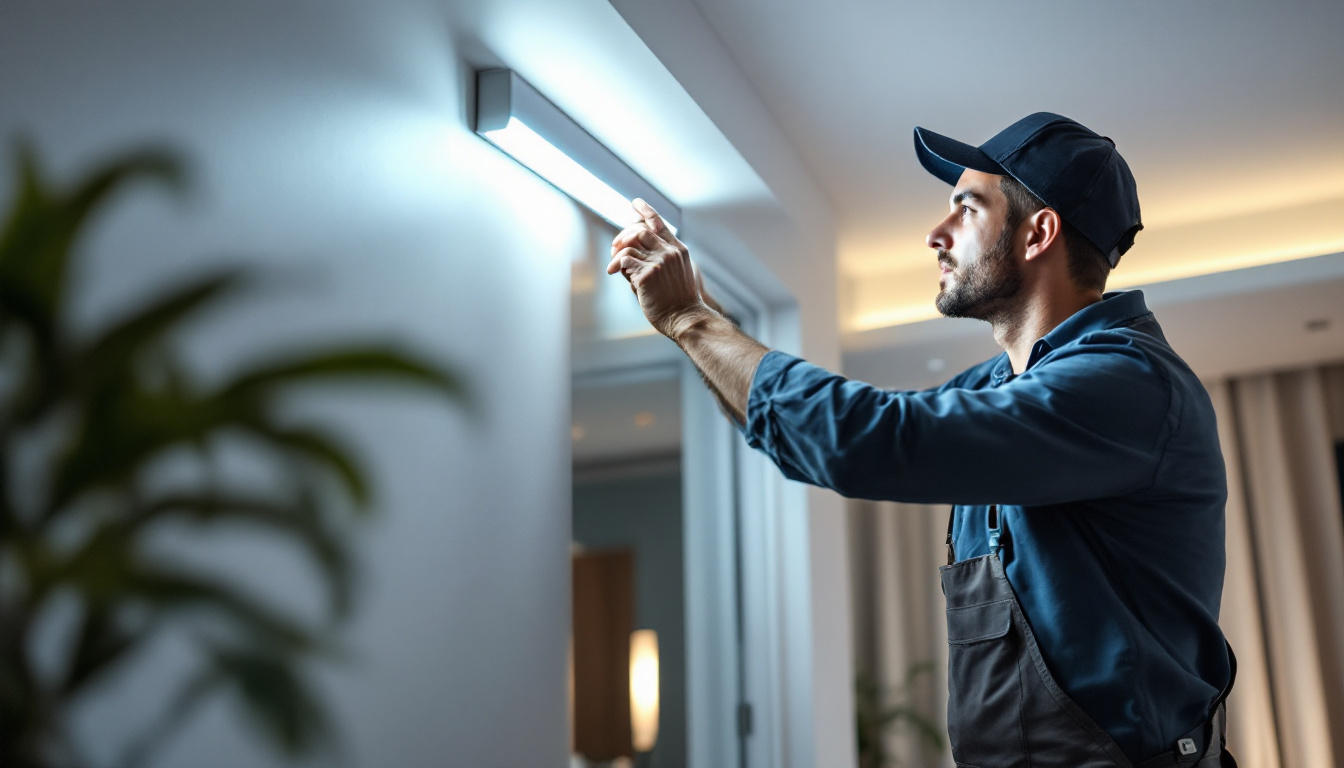
Architectural lamps play a crucial role in the world of lighting design, merging functionality with aesthetics to create spaces that are not only illuminated but also visually appealing. For lighting contractors, mastering the nuances of architectural lamps can elevate their projects and enhance client satisfaction. This article delves into the secrets that lighting contractors should know to effectively work with architectural lamps, ensuring that they achieve the desired ambiance and functionality in their designs.
Architectural lamps are specifically designed to complement the structure and style of a building. They serve both practical and decorative purposes, illuminating spaces while enhancing architectural features. Understanding the different types of architectural lamps is essential for contractors looking to make informed decisions in their projects.
There are several types of architectural lamps, each serving unique functions. Recessed lighting, for instance, is popular for its clean look and ability to blend seamlessly into ceilings. Pendant lights, on the other hand, can serve as focal points, drawing attention to specific areas within a space. These fixtures come in a variety of styles, from minimalist designs to ornate chandeliers, allowing for versatility in design and function.
Other types include wall sconces, which add warmth and dimension to walls, and track lighting, which offers flexibility in directing light. Wall sconces can be strategically placed to highlight artwork or architectural details, while track lighting can be adjusted to illuminate different areas as needed. Understanding the characteristics and applications of each type is vital for contractors to select the right fixtures for their projects. Moreover, integrating smart lighting solutions can enhance the functionality of these fixtures, allowing for remote control and automation that can adapt to the needs of the space throughout the day.
When selecting architectural lamps, several key features should be considered. Lumens and wattage are crucial for determining the brightness of a fixture, while color temperature affects the mood of the space. Warmer tones create a cozy atmosphere, while cooler tones can make a space feel more modern and open. The choice of color temperature can significantly influence how colors are perceived within the space, making it essential for contractors to consider the intended use of each area when selecting lighting.
Additionally, energy efficiency is a critical factor. LED lamps are increasingly popular due to their longevity and lower energy consumption. They not only reduce electricity bills but also have a smaller carbon footprint compared to traditional incandescent bulbs. Contractors should keep abreast of the latest technologies and trends in lighting to provide clients with the best options available. Incorporating features such as dimming capabilities or smart controls can further enhance the user experience, allowing for a tailored lighting solution that meets both aesthetic and functional needs. Furthermore, considering the materials and finishes of the fixtures can also play a significant role in achieving a cohesive design that aligns with the overall architectural vision of the project.
Effective design is at the heart of any successful lighting project. Architectural lamps can significantly influence the overall aesthetic and functionality of a space. Understanding how to integrate these fixtures into a design scheme is essential for lighting contractors.
One of the fundamental principles of lighting design is the concept of layering light. This involves combining ambient, task, and accent lighting to create a well-balanced and functional environment. Architectural lamps can serve in all three capacities, depending on their placement and type.
For instance, recessed lights can provide ambient lighting, while pendant fixtures can offer task lighting over work areas. Accent lighting, such as wall sconces, can highlight artwork or architectural features, adding depth and interest to the space. Additionally, using dimmable fixtures can enhance the versatility of these layers, allowing for adjustments based on the time of day or the activity taking place. This flexibility is particularly beneficial in multi-purpose spaces, where the lighting needs may shift throughout the day.
While aesthetics are important, functionality should never be overlooked. Architectural lamps must not only look good but also serve their intended purpose effectively. This balance is crucial in commercial spaces where lighting impacts productivity and safety.
Contractors should work closely with clients to understand their needs and preferences, ensuring that the selected fixtures enhance both the beauty and functionality of the space. This collaborative approach can lead to more satisfied clients and successful projects. Furthermore, considering the energy efficiency of architectural lamps is increasingly important in today’s design landscape. Selecting LED fixtures not only reduces energy consumption but also extends the lifespan of the lighting, providing long-term cost savings. By integrating sustainable practices into the design process, contractors can offer solutions that are not only visually appealing but also environmentally responsible, aligning with the growing demand for green building practices.
The installation of architectural lamps requires precision and expertise. Proper installation is vital to ensure that the fixtures perform optimally and meet safety standards. Lighting contractors should be well-versed in various installation techniques to handle different types of architectural lamps.
Recessed lighting installation involves cutting holes in the ceiling and securing the fixtures in place. It is essential to consider the ceiling structure and insulation to avoid any potential issues. Proper placement is also crucial; fixtures should be spaced appropriately to achieve even lighting throughout the space.
Contractors should also be familiar with the different types of recessed fixtures, including new construction and remodel housings, to select the right option for each project. Understanding the electrical requirements and ensuring compliance with local codes is also critical during installation.
Pendant lights and sconces require different installation techniques. Pendant lights often involve hanging from a ceiling fixture, which may require additional support depending on their weight and size. Contractors should ensure that the mounting hardware is secure and that the height is appropriate for the space.
Wall sconces, on the other hand, must be mounted at a height that provides adequate illumination without obstructing movement. The placement should also consider the surrounding decor to enhance the overall design. Proper wiring and adherence to safety standards are essential for both types of installations.
Once installed, architectural lamps require regular maintenance to ensure they continue to function effectively and look their best. Lighting contractors should educate clients on proper care and maintenance practices to prolong the life of their fixtures.
Dust and dirt can accumulate on lamps, diminishing their brightness and overall appearance. Regular cleaning is essential, and contractors should recommend appropriate cleaning methods based on the materials of the fixtures. For example, glass fixtures may require gentle cleaning solutions, while metal fixtures might need polishing to maintain their shine.
Additionally, contractors should advise clients on the importance of checking bulbs regularly and replacing them as needed. This simple practice can prevent dim lighting and ensure that spaces remain well-lit and inviting.
Even with proper maintenance, issues can arise with architectural lamps. Flickering lights, for instance, may indicate a problem with the fixture or the electrical supply. Contractors should be prepared to troubleshoot common issues and provide solutions to clients.
Understanding the electrical systems and components involved in lighting can help contractors diagnose problems quickly. This knowledge not only enhances the contractor’s reputation but also builds trust with clients, who appreciate prompt and effective service.
The world of architectural lighting is constantly evolving, with new trends emerging regularly. Staying informed about these trends can help lighting contractors remain competitive and offer innovative solutions to their clients.
Smart lighting technology is revolutionizing the way spaces are illuminated. With the ability to control lighting through smartphones or voice commands, clients are increasingly seeking smart solutions for their homes and businesses. Contractors should familiarize themselves with various smart lighting options, including programmable fixtures and systems that integrate with home automation.
Implementing smart lighting not only enhances convenience but also allows for greater energy efficiency. Contractors can provide clients with solutions that adapt to their lifestyles while promoting sustainability, a growing concern in today’s market.
As environmental awareness increases, clients are becoming more conscious of their energy consumption and the materials used in their lighting fixtures. Contractors should prioritize sustainable options, such as LED lamps and fixtures made from recycled materials. This not only meets client demands but also aligns with broader trends toward eco-friendly practices.
Incorporating sustainable solutions into projects can enhance a contractor’s reputation and attract clients who prioritize environmental responsibility. Educating clients on the benefits of sustainable lighting can also foster long-term relationships built on trust and shared values.
Architectural lamps are a vital component of effective lighting design, and mastering their intricacies can significantly benefit lighting contractors. From understanding different types of fixtures to implementing innovative technologies, the secrets to success in this field are multifaceted.
By focusing on design principles, installation techniques, maintenance practices, and emerging trends, contractors can enhance their expertise and deliver exceptional results for their clients. As the lighting industry continues to evolve, staying informed and adaptable will be key to thriving in this dynamic environment.
Ultimately, the mastery of architectural lamps not only elevates the quality of lighting projects but also contributes to the overall satisfaction of clients, making it a worthwhile pursuit for any lighting contractor.
Ready to take your lighting projects to the next level? At LumenWholesale, we provide lighting contractors with the highest quality, spec-grade architectural lamps at unbeatable wholesale prices. Say goodbye to local distributor markups and hello to our premium selection that meets the strictest industry standards. With free shipping on bulk orders, you can trust that you’re getting the best value without any hidden costs. Elevate your designs and delight your clients with reliable, high-performance lighting solutions. Discover the ideal combination of quality, affordability, and convenience. Visit LumenWholesale now and secure the best value in wholesale lighting for your next project.

Discover the essential insights lighting contractors need to meet client expectations with Candiler.

Discover why the 4 bulb T8 ballast is a game-changer for lighting contractors.

Illuminate your projects with precision using our comprehensive guide on 4-foot LED strip lights.

Discover how recessed LED lighting can transform your space with energy-efficient and stylish solutions.